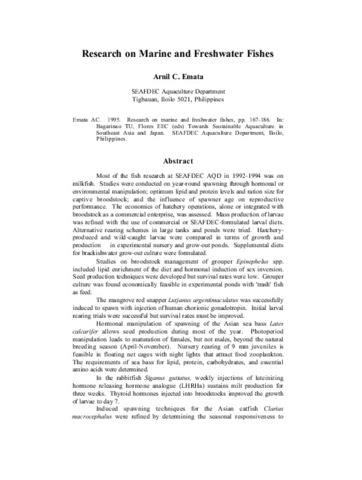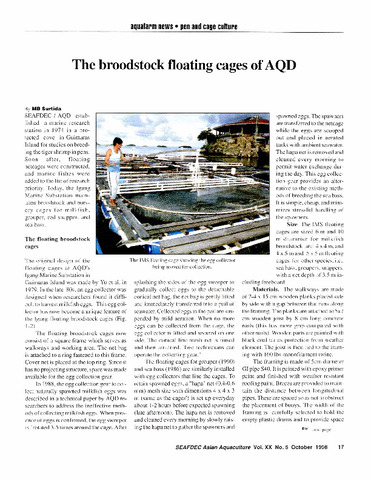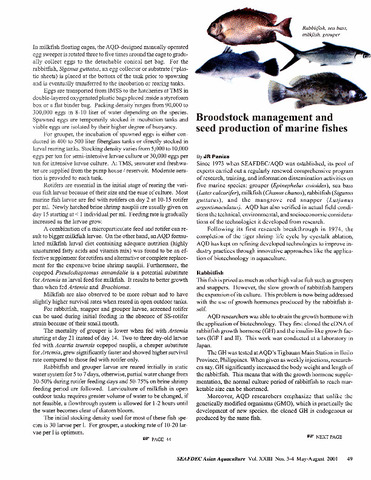Review of SEAFDEC/AQD finfish seed production research
Share
Abstract
Research on seed production of several foodfishes has been a continuing activity of SEAFDEC/AQD since 1976. Fry and juvenile production methods of these fish commodities are in various stages of advancement. For instance, advances in the development of hatchery rearing, particularly feeding and water management schemes, have made mass production of milkfish (Chanos chanos) seed a reality, resulting further in the application of the technology in commercial hatcheries. Recent studies now focus on assessing the quality of hatchery seed stocks of milkfish vis-a-vis wild seed during nursery and grow-out culture. Likewise, sea bass (Lates calcarifer) seed production has undergone significant improvements since the technology was introduced in the Philippines in 1982. Fatty acid-enrichment of a zooplankton diet can enhance growth and survival of sea bass fry, although other cheaper alternatives and early weaning to formulated diet preparations are currently being tested. Hatchery fry production of grouper (Epinephelus salmoides and E. suillus syn. E. coioides) and snapper is in its infancy, but trials complemented by research on their larval feeding habits and requirements are underway to establish reliable methods of rearing larvae of these species. Although fairly well-established, seed production of rabbitfish (Siganus guttatus) requires further improvement in determining an appropriate zooplankton diet to ensure adequate growth and survival of larvae. Hatchery fry production of tilapia (Oreochromis sp.), carps (Aristichthys nobilis, Hypothalmichthys molitrix) and, to a certain extent, catfish (Clarias macrocephalus) can already be categorized as a flourishing industry in some parts of the Philippines. Nonetheless, SEAFDEC/AQD continues to conduct research on these freshwater species, with particular emphasis on nutrition and feed development during the nursery production phase. Together, results of past and on-going research studies ensure that seed supply of these important foodfishes become adequate and sustainable for the grow-out.
Suggested Citation
Quinitio, G. F., Duray, M. N. (1996). Review of SEAFDEC/AQD finfish seed production research. In C. L. Marte, G. F. Quinitio, & A. C. Emata (Eds.), Proceedings of the Seminar-Workshop on Breeding and Seed Production of Cultured Finfishes in the Philippines, Tigbauan, Iloilo, Philippines, 4-5 May 1993 (pp. 119-131). Tigbauan, Iloilo, Philippines: Aquaculture Department, Southeast Asian Fisheries Development Center.
Paksa
seed (aquaculture)  ; diet
; diet  ; cultured organisms; juveniles
; cultured organisms; juveniles  ; fry
; fry  ; larvae
; larvae  ; seed production
; seed production  ; larval stage
; larval stage  ; sustainability
; sustainability  ; hatcheries; research institutions
; hatcheries; research institutions  ; rearing techniques
; rearing techniques  ; aquaculture development
; aquaculture development  ; nutritional requirements
; nutritional requirements  ; feeding experiments
; feeding experiments  ; fish culture
; fish culture  ; Clarias macrocephalus
; Clarias macrocephalus  ; Chanos chanos
; Chanos chanos  ; Siganus guttatus
; Siganus guttatus  ; Lates calcarifer
; Lates calcarifer  ; Epinephelus coioides
; Epinephelus coioides  ; Giant perch; Golden rabbitfish; milkfish
; Giant perch; Golden rabbitfish; milkfish  ; Philippines, Panay I., Iloilo
; Philippines, Panay I., Iloilo
 ; diet
; diet  ; cultured organisms; juveniles
; cultured organisms; juveniles  ; fry
; fry  ; larvae
; larvae  ; seed production
; seed production  ; larval stage
; larval stage  ; sustainability
; sustainability  ; hatcheries; research institutions
; hatcheries; research institutions  ; rearing techniques
; rearing techniques  ; aquaculture development
; aquaculture development  ; nutritional requirements
; nutritional requirements  ; feeding experiments
; feeding experiments  ; fish culture
; fish culture  ; Clarias macrocephalus
; Clarias macrocephalus  ; Chanos chanos
; Chanos chanos  ; Siganus guttatus
; Siganus guttatus  ; Lates calcarifer
; Lates calcarifer  ; Epinephelus coioides
; Epinephelus coioides  ; Giant perch; Golden rabbitfish; milkfish
; Giant perch; Golden rabbitfish; milkfish  ; Philippines, Panay I., Iloilo
; Philippines, Panay I., Iloilo
Taxonomic term
Mga koleksyon
Related items
Showing items related by title, author, creator and subject.
-
Research on marine and freshwater fishes
Emata, Arnil C. (Aquaculture Department, Southeast Asian Fisheries Development Center, 1995)Most of the fish research at SEAFDEC AQD in 1992-1994 was on milkfish. Studies were conducted on year-round spawning through hormonal or environmental manipulation; optimum lipid and protein levels and ration size for ... -
The broodstock floating cages of AQD
Surtida, Marilyn B. (Aquaculture Department, Southeast Asian Fisheries Development Center, 1998) -
Broodstock management and seed production of marine fishes
Paniza, J. R. (Aquaculture Department, Southeast Asian Fisheries Development Center, 2001)





